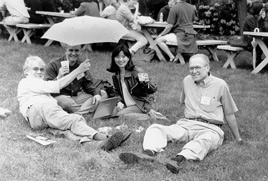2001: The Ribosome, Vol. LXVI
Organizer: Bruce Stillman
How proteins are made became a major focus following the discovery of the double-helical structure of DNA in 1953. Once it was realized that the genetic code existed within the order of base pairs of DNA, it became of immediate importance to understand how that information was converted into the sequences of amino acids that defined individual proteins. The solution of this problem, which includes deciphering the genetic code, is one of the great achievements in the science that is now known as molecular biology. Many of these achievements have been recorded and celebrated at previous Symposia in this series.
Protein synthesis occurs within the ribosome, a molecular machine comprising both protein and RNA that in eukaryotes is first assembled in the nucleus of a cell. RNA also functions as the adaptor in the form of tRNA that brings the individual amino acids to the ribosome. Ribosomes themselves associate with other molecular machineries, such as the machinery that directs proteins to the cell surface. It was once thought that figuring out the molecular details of how protein synthesis occurs would long be an insurmountable problem. But dramatic events in structural biology in recent years have changed this view and are the reason for selecting the ribosome as the topic for this yearâs Symposium.
High-resolution images of the structure of a ribosome not only tell us how beautiful this ma¬chine is, but reveal the surprising finding that peptide-bond formation is directed by RNA. Although this had been hinted at for some time, it was difficult to envision without seeing the ribosome structure. The structure of the ribosome, either as its individual parts or as a whole, has also shown how the newly minted peptide chain emerges and, in the case of some proteins, how it interacts with other molecular machinery that exports proteins to the cell surface.
First and foremost, I am most appreciative of the help
| 
from David Stewart, Director of our very efficient meetings and courses division, in organizing this meeting. I am also particularly grateful to Peter Moore, Tom Steitz, Michael Mathews, Alan Hinnebusch, and Susan Gerbi for advice on areas of research to be covered. The meeting started with a talk by Jim Watson about his early and important role in the ribosome field while on the faculty at Harvard. Later followed outstanding introductory presentations by Tom Steitz, Venki Ramakrishnan, Nahum Sonenberg, and Roland Beckmann. The Friday evening Reginald Harris Lecture was masterfully presented by Harry Noller, and the Dorcas Cummings Memorial Lecture to our friends and neighbors was beautifully presented by Venki Ramakrishnan. There were 60 oral presentations and 136 poster presentations over the course of the meeting, which was held from May 31 to June 4. On the fi¬nal day, Peter Moore presented us with a very thoughtful summary that is formalized at the end of this volume.
Particularly pleasing at this meeting was the return to Cold Spring Harbor Laboratory of many of the principal contributors to the early days of ribosome research who reminisced about ex¬periments that contributed to understanding, at a most fundamental level, the central dogma of biology. They included Alfred Tissières, Donald Caspar, and Alex Rich.
— Peter Sherwood |